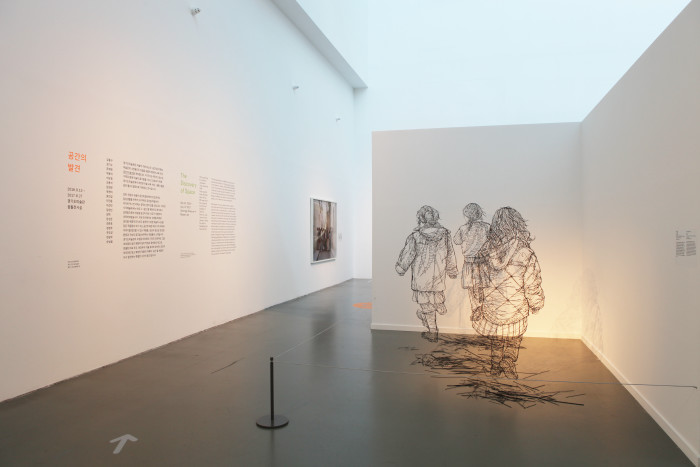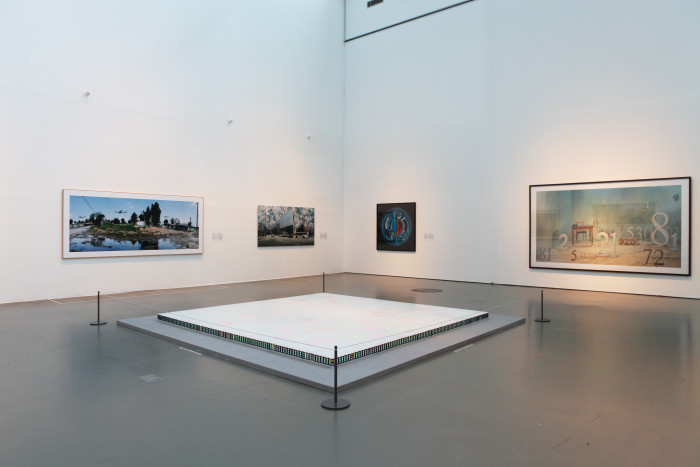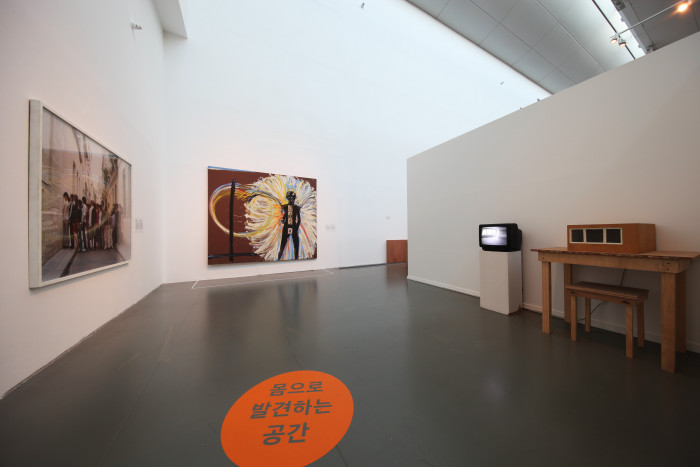경기도미술관
The Discovery of Space
2016-09-13 ~ 2017-08-27 / Gyeonggi Museum of Modern Art 2F Dream Studio
Kaye Yoon
Curator, Gyeonggi Museum of Modern Art
Prologue
Shortly after the exhibition The Discovery of Space opened, a few college students came to see me. They had some questions about the exhibition and asked if they could interview me. They even said that they would like use it as a study material for class.
Is there anything that I will not do for students who come to the museum, or this space of learning, to learn? I gladly accepted their request and answered all of their questions with all earnestness. They cast considerably concrete questions such as what inspired us to organize the exhibition, what made us decide the exhibition theme as space, how the arrangement of the exhibit is, and what we want the audience to know in this exhibition. Afterwards, when I was preparing the publication of the exhibition catalogue and thinking about how to write the introduction, I came up with the possibility that these students’ questions could be the common concern for those who would have interest in this exhibition and read the catalogue. Therefore, this introduction is largely based on my answers to them.

The Museum, a Space of Learning
What expectation leads people to the museum? According to the various surveys of the visitors to the museums in Seoul and Gyeonggi Province in 2014 and 2015, the first purpose of the museum visit was “to satisfy the intellectual curiosity.” People come to the museum because they are much interested in art, and because they want to know more about art. Nevertheless, it is not so easy to fulfill the task of learning in the museum dedicated to contemporary art. Because not only works of art on display but also captions explaining the exhibition itself and works are difficult to understand, most of the visitors find them incomprehensible without an audio guide. Far from knowing more about or enjoying art, they often back home only with unpleasantness or embarrassment.
Although such is the case, the number of the museum visitors has increased year by year. The increase of interest in and need for creative learning, social studies, or lifelong education generally lifted the expectation for and response to the role of the museum as an alternative education institution. In the mornings on weekdays, except for mid-summer and mid-winter days, the museum is crowded with visitors who come to know about art, from a group of five year old children to high school students. The number of family visitors on weekends has been constantly raised.

The Gyeonggi Museum of Modern Art performs not only its proper duty of introducing the theme and form of the latest contemporary art, but also has worked to build the bridge of learning between contemporary art and the audience. Through the project titled “Dream Studio,” the museum is part of its education programs to help visitors to experience that appreciating contemporary art is difficult but a pleasant process of intellectual inquiry, and to understand and consider how art has an influential relationship with our life in general.
Dream Studio Deals with the Basic Elements of Art
What should we present to those who come to the museum to know more about art, from children to adults? The answer of the Gyeonggi Museum of Modern Art was to show them the most museumlike. For this purpose, Dream Studio project has planned and organized exhibitions and learning programs, making a theme out of the basic elements of art such as color, space, and form, and in particular, for exhibitions, selected among the 500 works of its collection which most clearly show the nature and characteristics of the museum. In that these exhibitions cover all ages from children and teenagers to grown-ups, all the works presented in the exhibition hall have clear and easy to understand explanations in order that art appreciation will not be embarrassing. And experiencing activities in the middle and end of the exhibition will also help visitors to maintain their interest and pleasure.

Dream Sudio learning programs are opened to a group of preschoolers, elementary and middle school students, and families. The participants have an experience to free their thoughts by means of art, such as looking for the basic elements of art in everyday life, “giving colors to colorless objects,” or “measuring a space without a measuring tape.” And since the exhibition is changed in every September and the learning programs in every semester and vacation, visitors who visit even many times a year will be able to see and experience new things.
In 2015, Dream Sudio organized the exhibition titled Color Pool and learning programs under the theme of ‘color,’ and attracted 60,393 visitors for the 12 months from September 17, 2015 to August 28, 2016. From September, it explores various artistic attempts to take a view of the world we are belong to, under the theme of ‘space’ which is at once one of the essential elements of visual art, and a vessel to carry our everyday life.

The Discovery of Space
It is impossible to define space with a single concept. The term has countless textures of meanings: “an empty place where there is nothing,” “a venue where some matter or an object can exist or where an event can take place” such as urban space, cultural space and rest space, “a realm or a sphere” such as the space of life, the space of imagination, and even a physical space such as three-dimension or four-dimension. And all these definitions are valid for the relationship with an individual who talks about it. What we aim to discover through the exhibition theme, space is, eventually, a human being, that is, I. It is intended to tell the story of how I see, perceive, and remember the space to which I belong and in which I am living. For this, the exhibition features the works which show an artistic attempt to newly recognize and discover space through the medium of the body, which help the audience to find out various meanings and stories about the place I am living in, and which show the illusory and fictitious world created by imagination.

The first section, “Space Discovered by the Body” is about the artistic attempts to perceive and discover space in a new way. Sungeun Chang measured the width of a road by using the length of the human body as a unit and took a picture of the moment. The width of the road in the photograph is “19 persons.” Kunyong Lee, who asks “why a painter should paint facing the canvas?”, placed the canvas over or beside his body or lay it on the floor and painted using the traces of the body, making the audience think about the space and limitation which the being called I. The design project group COM makes a labyrinth in a part of the exhibition space and leads visitors to concentrate on their own psychological and physical responses and senses in this extra-daily situation.

The second section, “The Space I Am Living in” introduces the works which have the discoveries of the various meanings and stories about the spaces of living, such as a city, a street, a house, etc. Yongseok Park photographed houses in a city and marked the positions of the yellow or blue water tanks on the roof of houses, transforming the conventional image of a city to a new urbanscape composed only of color dots. Sunmin Lee calmly records the scene of holding a memorial service in a home, revealing the discomfort of the patriarchal culture still existing in modern home through the contrast between the two spaces inside and outside the room.
The last section, “The Space Created by Imagination” is composed of the works dealing with illusory or imaginary spaces which are based on facts but created by imagination. The “Tomorrow” series by Seounwon Won worked out a scene by inspiring the past events and memories with warmth and hope, and embodies the world of pleasant imagination by patching photographs of the real time-spaces. Hyunmi Yoo represented a scene from a novel, The Little Prince in a real space, added some painterly touches, and took pictures of it, crossing between fiction and fact, and between reality and illusion. Joonho Jeon produced an animation based on North Korean currency, full of original imagination, which satires the tendencies of North Korean society. At the end of the exhibition, there is a permanent corner for an experience activity using block play. Here, visitors can embody their memory or imagination of which they were reminded while seeing the works.

Epilogue
One of the viewers who visited the exhibition The Discovery of Space left a comment in the visitors’ comment book: “Some works brought me memories and some works put me into deep thought. Thank you.” A work of art which moved the heart is hardly ever forgotten. Though you think you have forgotten it, it will abruptly come across your mind; while you believe it disappeared from your memory, you will suddenly find that it has settled in your mind, just to extend your values, to decide the direction of your behavior, and to bring a change in your life. So it is important more than anything to become familiar with a museum and frequently see works of art. And these would be exactly what are expected by those who visit a museum. I sincerely wish that every visitor of the Gyeonggi Museum of Modern Art would meet a work of art that will linger long in the memory, as well as that this exhibition would make them view their everyday life and space from a new perspective. Today as before, we plan another new exhibition in the hope that the experience in this museum would be a fresh awakening to life, healthy air to breathe in, and the pleasure of life to someone.
<ggc의 모든 콘텐츠는 저작권법의 보호를 받습니다.>
세부정보
The Discovery of Space
Period/ Sep 13, 2016 – Aug 27, 2017
Venue/ Gyeonggi Museum of Modern Art 2F Dream Studio
Participated artists/ Honggoo Kang, Kisoo Kwon, Jaye Moon, Yongseok Park, COM, Yongseok Oh, Seoungwon Won, Hyunmi Yoo, Minseop Yoon, Kunyong Lee, Sunmin Lee, Sangbin Im, Taek Lim, Sungeun Chang, Joonho Jeon, Jeongju Jeong, Doyang Zu, Kwangwoo Han, Sungpil Han
Organized by/ Gyeonggi Cultural Foundation
Curated by/ Gyeonggi Museum of Modern Art
Supported by/ Samhwa Paints
@참여자
- 글쓴이
- 경기도미술관
- 자기소개
- 경기도미술관은 경기도가 지원하고 경기문화재단이 운영하는 도립미술관으로서, 조사와 연구를 바탕으로 한 현대미술작품의 수집, 동시대적이고 창의적인 기획전, 그리고 관람객과 경기도민을 위한 다양한 교육 프로그램을 기획, 운영하는 미술관입니다.